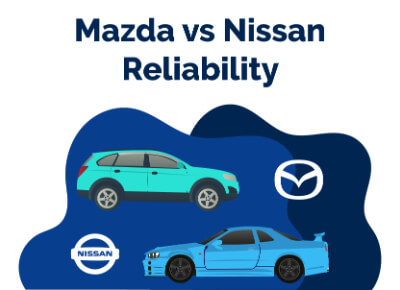Mazda vs Nissan: Reliability Comparison
July 12, 2023


Chris is Head of Content for FindTheBestCarPrice and is based out of Philadelphia, PA. As a seasoned automotive industry analyst and car enthusiast, he ensures the highest level of quality across all our content and curates our picks for the best deals each month.
Chris studied information systems and marketing at Drexel University and writes about a wide range of topics ranging from car buying tips to troubleshooting common mechanical issues.
When he’s not thinking about cars, he likes to stay in with his dog and make an “attempt” to finish a crossword puzzle (he’s not quite at the Saturday/Sunday level…yet). As a former cheesemonger, Chris still has a “sharp” passion for all things cheese, and his fridge is always loaded with it!
Chris also has a passion for things that go fast, and drones are no exception. He spends some of his time writing for Dronesourced.
In this post, we delve into a detailed comparison of Mazda and Nissan, focusing on the reliability aspect of their vehicles.
We'll examine various factors such as build quality, longevity, common issues, and consumer feedback to provide you with a comprehensive understanding of how these two popular automotive brands stack up against each other in terms of reliability.
Whether you're considering a new purchase or just curious about these manufacturers, this comparison aims to offer valuable insights to help you make an informed decision.
Let's get started.
Table of Contents
Detailed Comparison
| Features | Mazda | Nissan |
| Design | ||
| Repairs and Maintenance Cost | ||
| Durability | ||
| Engine | ||
| Gas Mileage | ||
| Technology | ||
| Safety |
Which Is the Best Car: Mazda or Nissan?
Determining which automaker produces the best car is a perpetual debate that has piqued the interest of car enthusiasts and casual drivers alike.
Mazda and Nissan are two renowned brands that have consistently delivered on their promise of producing exceptional cars. However, identifying the clear winner in the Mazda vs. Nissan rivalry can be daunting.
Mazda vehicles are renowned for their captivating design, agile handling, and innovative technology.
Mazda engineers have prioritized the driving experience, incorporating advanced features such as G-Vectoring Control, which enhances vehicle stability and control, giving drivers an exhilarating sense of control on the road.
Additionally, Mazda vehicles' fuel-efficient powertrains and extensive safety features further cement the automaker's reputation for producing high-quality vehicles.
Conversely, Nissan has built a reputation for producing practical, dependable vehicles catering to diverse drivers. Nissan cars are known for reliability, with many models consistently scoring high on industry reliability ratings.
The automaker's lineup ranges from efficient city cars to rugged SUVs, providing options for families, adventurers, and everyone in between.
Nissan also boasts cutting-edge technology, such as the ProPILOT Assist system, which enhances driver assistance and safety.
While both automakers have a history of producing top-notch vehicles, the ultimate winner in the Mazda vs. Nissan debate depends on individual needs and preferences.
Those prioritizing performance, innovative technology, and a thrilling driving experience may lean towards Mazda. At the same time, those who value reliability, practicality, and versatility may prefer Nissan.
Design
Mazda's commitment to innovation and experimentation is exemplified in their KODO design language, which translates to "Soul of Motion."
Their cars feature sculpted and muscular looks, with crisp lines and a sense of tension that sets them apart.
However, Mazda's approach to design goes beyond aesthetics, prioritizing performance with lightweight materials and advanced engineering that create agile and responsive vehicles.
On the other hand, Nissan embodies the unique Japanese perspective, with a reverence for nature, meaning, and consideration for others' impact.
Nissan has adapted this Japanese DNA to the changing times through their Nissan Design J-DNA, which encompasses a more universal and global perspective. Their approach leads to a better society and a more enjoyable life through cars.
Mazda and Nissan have been designed with drivers' best interests in mind. Mazda's cars embody elegance and sophistication, attracting those who value precision and refinement.
At the same time, Nissan's approach prioritizes a better society and a more enjoyable life through cars.
Winner: Both
Repair and Maintenance Cost
Mazda's reputation for producing affordable and reliable cars extends to their maintenance and repair cost, which averages $8,035 during the first ten years of service.
Although this cost is slightly higher than the industry average for famous brands, it still presents buyers with a more manageable financial burden.
Moreover, Mazda's models have a relatively low likelihood of requiring significant repairs, falling within the reasonable range for car models at 18.43%.
Conversely, Nissan's models come with an average maintenance and repair cost of $8,088 during their first ten years of service. While this amount is slightly higher than Mazda's cost, it still falls within a manageable range for car owners.
However, Nissan's models exceed the industry average by $1,274, which can burden buyers on a tight budget.
Winner: Both
Durability
Mazda has prioritized advanced research and development to produce dependable and long-lasting models. By utilizing cutting-edge engineering, attention to detail, and high-tech materials, Mazda has gained a significant advantage in durability, delivering vehicles that endure the test of time. Regarding reliability, Mazda receives a rating of 4.0 out of 5.0, placing fifth out of 32 car brands. This rating is based on an average across 345 unique models.
In comparison, Nissan has earned a good reliability rating of 4.0 out of 5.0, ranking the automaker in a decent ninth place out of 32 manufacturers, according to RepairPal. This rating is derived from evaluating the dependability of 245 different car models. Despite this, Nissan still ranks above several other cars, such as Subaru and Buick, in terms of durability.
After evaluating both brands, it is clear that Mazda has an edge in reliability and durability, placing it ahead of Nissan. Therefore, Mazda emerges as the winner in this comparison.
Winner: Mazda
Engine
Mazda's commitment to excellence in engineering and environmental sustainability is evident in its Skyactiv-G engines.
Thanks to advanced materials and technology, these engines deliver high efficiency without compromising power or performance.
In contrast, Nissan provides a variety of options for drivers.
One is a 1.6L 4-cylinder engine capable of delivering up to 180hp, and the other is a 2.5L 4-cylinder engine with 188hp. And for those who require more power, the 3.0L V6 delivers close to 300hp.
For eco-conscious drivers, Nissan's LEAF is an outstanding option. With its electric powertrain, which includes a forty kWh battery pack and 110 kW electric motor, the vehicle boasts an impressive range of up to 149 miles.
Mazda and Nissan offer impressive options for drivers. While Mazda's focus on engineering and sustainability is evident in their Skyactiv-G engines, Nissan provides a range of choices, including eco-friendly options like the LEAF.
Winner: Both
Gas Mileage
Regarding fuel efficiency, Mazda and Nissan have some impressive contenders. Mazda boasts the highest highway mpg rating among its 2022 models, with the Mazda3 Sedan taking the top at 36 mpg.
The Mazda MX-5 Miata and MX-5 Miata RF follow closely behind with a rating of 35 mpg.
The Mazda3 Hatchback and CX-30 score 34 and 31 mpg, respectively. The CX-5 and CX-50 round out Mazda's lineup with a rating of 30 mpg.
On the other hand, Nissan offers an electric option, with the Leaf earning an impressive 111 mpg. Among its gasoline models, the Nissan Versa takes the lead with 35 mpg, followed by the Nissan Kicks and Sentra at 33 mpg.
The Nissan Altima and Rogue score 32 and 30 mpg, respectively, while the Nissan Maxima and Murano drop to 24 and 23 mpg. The Nissan 370Z, TITAN, and Armada complete Nissan's lineup with 20, 18, and 16 mpg, respectively.
Overall, Mazda has a more robust lineup in terms of fuel efficiency, with more of its models achieving higher mpg ratings. Therefore, Mazda is the winner in this comparison.
Winner: Mazda
Technology
Mazda's MyMazda App and Connected Services provide drivers with advanced remote access features, vehicle status reports, and emergency service access. Its in-car Wi-Fi and entertainment features, including Apple CarPlay, Android Auto integration, and a 10-speaker Bose audio system, make it a clear winner in connectivity and entertainment.
In contrast, Nissan excels in electric vehicle battery technology, advanced driver assistance, and safety features. The ProPILOT system enables hands-off single-lane driving and is installed in many Nissan cars.
The brand's focus on optimizing the human-machine interface through extensive driving simulations and testing set it apart regarding safety and driver assistance.
Winner: Mazda
Safety
Mazda and Nissan prioritize safety and reliability in their vehicles. Mazda's i-Activsense®2 safety technology, which includes features such as Smart City Brake Support with Pedestrian Detection and Traffic Jam Assist, demonstrates their commitment to safety.
Furthermore, their 2022 IIHS Top Safety Pick+ award and 5-star overall safety rating prove their safety focus.
Nissan vehicles have a reputation for being reliable and safe, with many models achieving four or 5-star ratings in multiple crash tests conducted by the National Highway Traffic Safety Administration (NHTSA). Regular maintenance can help extend the life of Nissan vehicles even further.
Winner: Both
Final Verdict
While the Nissan is undoubtedly an excellent car, it falls just short of the Mazda in the Mazda vs. Nissan reliability contest.
It was a close race, with both brands performing neck-and-neck in most categories throughout the evaluation.
Best Car Deals by Category
Posted in Car Buying Tips, Car Troubleshooting |




